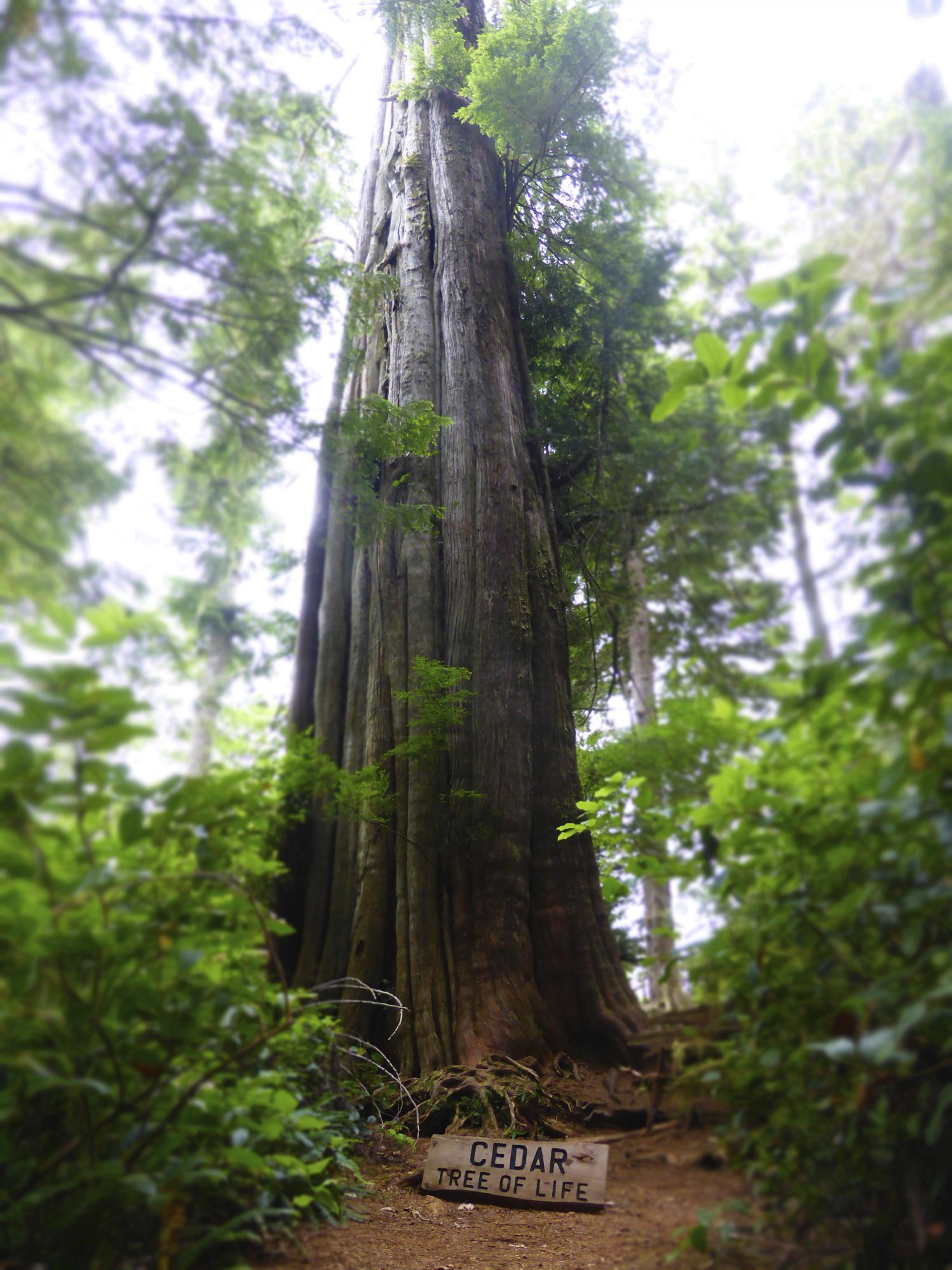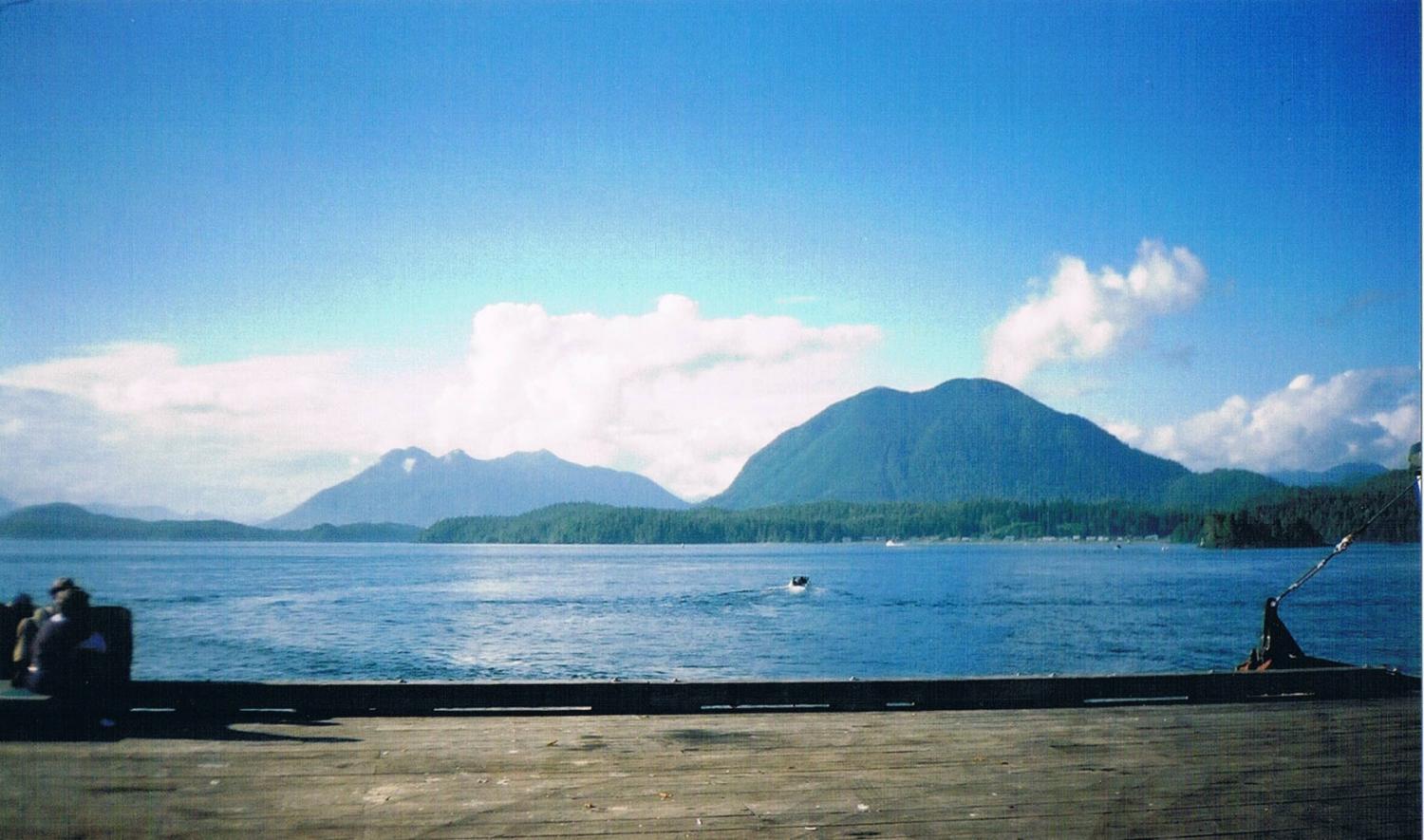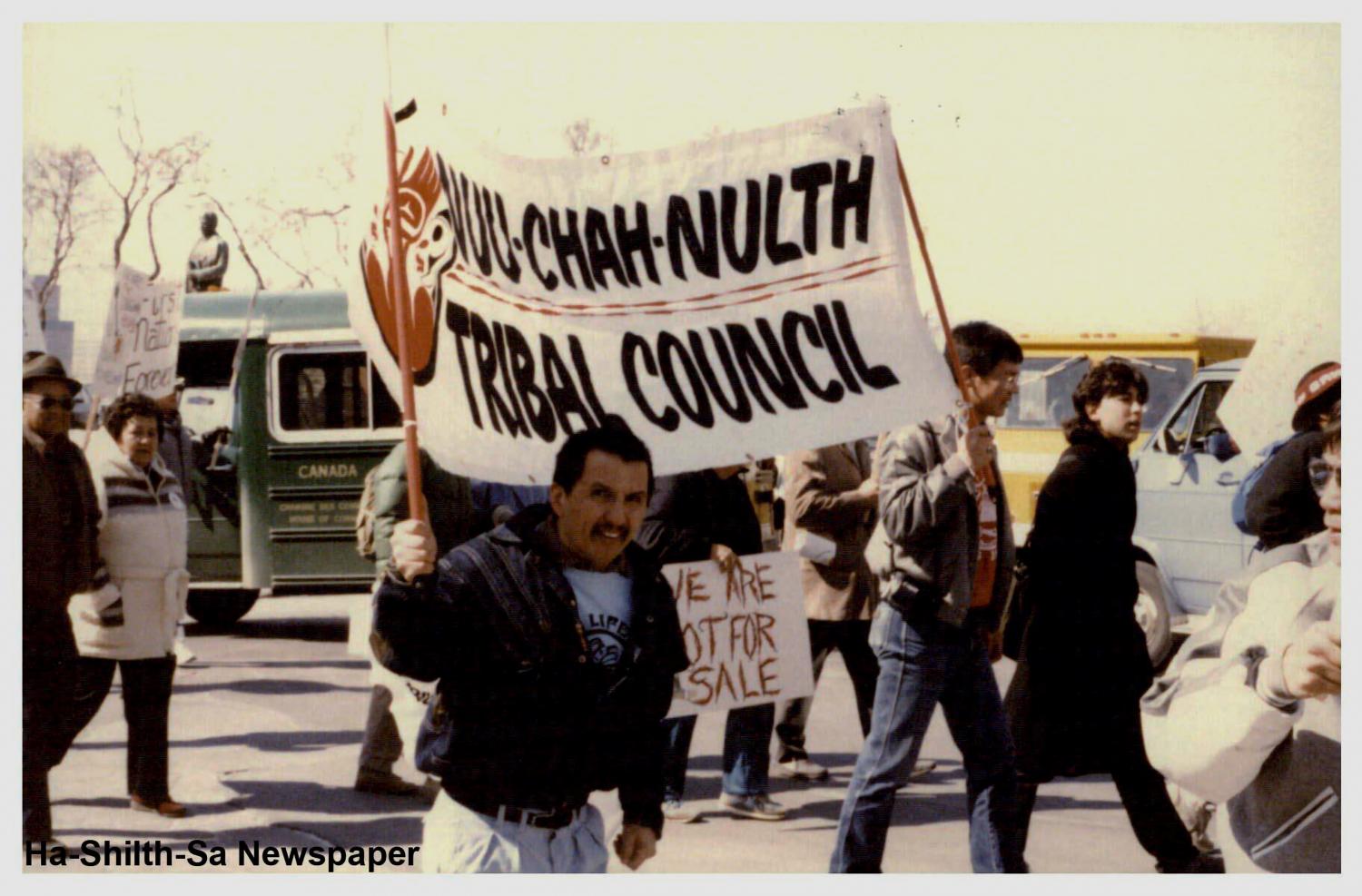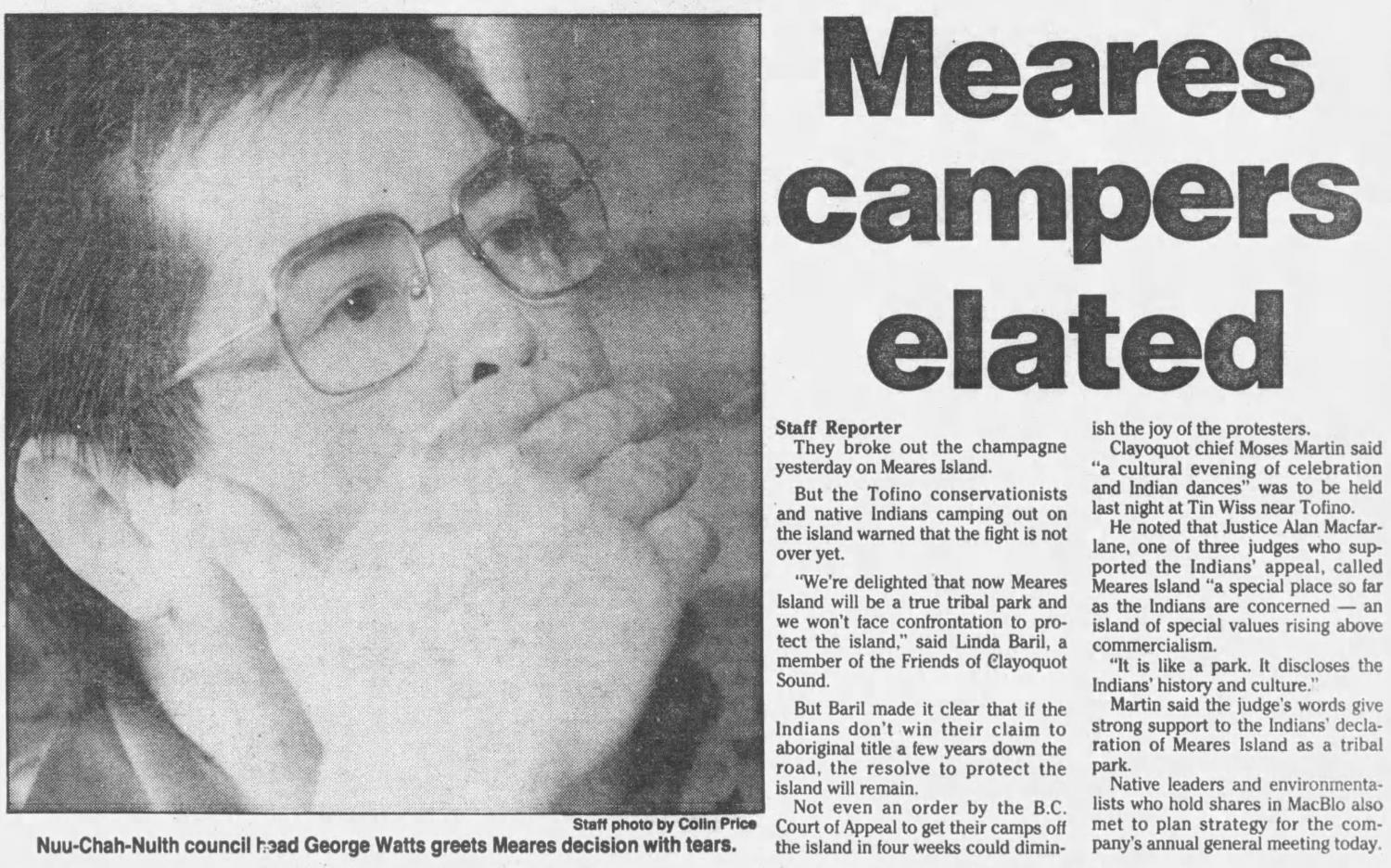First Logging Blockade
A fight to save old-growth forests and assert Aboriginal title on Meares Island
Date: 1984
On April 21, 1984, the Tla-o-qui-aht and Ahousaht First Nations declared Meares Island, home to some of the world’s oldest red cedars, a tribal park. The two Nuu-chah-nulth member nations made the unilateral declaration hoping to stop loggers from clearcutting much of the 21,000-acre island, situated just north of Tofino on Vancouver Island’s west coast.
Concern over the future of Meares Island, part of the Tla-o-qui-aht’s ancestral territory, began in 1979 when forestry giant MacMillan Bloedel announced its plans to log on the island, one of the region’s last pockets of untouched rainforest. Local Nuu-chah-nulth members and Tofino residents worried how that might impact their drinking water, which is sourced from Meares. Alarms were also raised over the ecological effects of aggressive logging, specifically on salmon, as well as the unsightly scars that clearcutting leaves behind. “At the worst, it will look like a minor dose of acne,” reassured Adam Zimmerman, chairman of MacMillan Bloedel, one of two companies with a licence to log on the island. His words seemed only to galvanize opposition, and not just in tourism-dependent Tofino. A poll conducted by the company found 78 per cent of British Columbians opposed logging on Meares Island.
Following three years of public consultation, the British Columbia government blindsided logging opponents when it announced in November 1983 that it would open up roughly 90 per cent of Meares Island to logging. This strayed far from the three proposals tabled by the government’s own planning team a year before: preserve half and log half; defer half for 25 years and log half; or preserve the whole island. In response, the Nuu-chah-nulth joined together with local residents and conservationists in an unprecedented campaign to save the island’s ancient trees, some as old as 1,500 years.
In November 1984, a few months after the Nuu-chah-nulth designated Meares Island a tribal park, Nuu-chah-nulth leaders partnered with environmentalist groups, like the Friends of Clayoquot Sound and the Western Canada Wilderness Committee, to set up Canada’s first-ever logging blockade at Heelboom Bay, also known as Cis-a-qis. When MacMillan Bloedel approached the island’s shore on Nov. 21, Moses Martin, then the elected chief of the Tla-o-qui-aht, greeted them. First, he read a statement asserting the Tla-o-qui-aht’s title to the island. Then he asked them to join him for a meal. “‘You’re welcome to visit our park,’” Martin recalled saying years later. “‘But leave your saws in the boat.’” The logging crew declined the invitation and left.
The blockade continued for months. Meanwhile, the fight moved from the woods into the courtroom. First, the B.C. Supreme Court granted MacMillan Bloedel an injunction to remove the protesters. The Tla-o-qui-aht countered with a separate injunction to block logging until their claim to Meares Island, most of which is Crown land, is resolved. On March 27, 1985, the court sided with the Tla-o-qui-aht in an historic 3-2 decision. Logging the island, according to the judges, would destroy physical evidence supporting the Tla-o-qui-aht’s claim to have lived on Meares Island for millennia. The case was adjourned, and the injunction remains in place to this day.
In his remarks, Justice Peter Seaton emphasized the need for governments to address Indigenous land claims. “The Indians have pressed their land claims in various ways for generations. The claims have not been dealt with and found invalid. They have not been dealt with at all,” he wrote. “Meanwhile, the logger continues his steady march, and the Indians see themselves retreating into a smaller and smaller area.”
The action to protect Meares Island was the first salvo in the War of the Woods, a grassroots movement to save old growths in Clayoquot Sound in the early 1990s.
Sources:
- Athlii Gwaii 25 Years Down the Road. Haida Laas, Nov. 2010, https://www.haidanation.ca/wp-content/uploads/2017/03/jl_nov.10.pdf.
- Blomley, Nicholas. "‘Shut the Province Down’: First Nations Blockades in British Columbia, 1984-1995." BC Studies, vol. 111, 1996, doi:https://doi.org/10.14288/bcs.v0i111.1361.
- Brown, Nancy. "Indians to Battle Logging." Victoria Times Colonist, 21 Oct. 1984, p. 1.
- "Clayoquots Want Meares Island Declared Tribal Park." Victoria Times Colonist, 10 Dec. 1983, p. 15.
- Dawes, Clarissa. "How First Nations-Led Protests in Canada Sparked a Conservation Movement." National Geographic, 8 Oct. 2020, https://www.nationalgeographic.com/travel/article/how-vancouver-island-protest-launched-first-nations-conservation-movement.
- Hamilton, Gordon. "Meares’ Ruling Latest Cut in a 5-Year Feud." Vancouver Sun, 28 Mar. 1985, p. 2.
- Harris, Douglas C. "A Court Between: Aboriginal and Treaty Rights in the British Columbia Court of Appeal." BC Studies, vol. 162, Summer 2009, https://core.ac.uk/download/pdf/228421816.pdf.
- “History.” Friends of Clayoquot Sound, http://focs.ca/about-focs/history/. Accessed 26 May 2021.
- Joseph, Bob. "Meares Island Case 1985." Working Effectively with Indigenous Peoples, 12 Oct. 2014, https://www.ictinc.ca/blog/meares-island-case-ongoing.
- "Meares Campers Elated." Vancouver Province, 28 Mar. 1985, p. 3.
- "Meares Island a Tribal Park." Victoria Times Colonist, 24 Apr. 1984, p. 3.
- "Meares Island Logging Okayed." Victoria Times Colonist, 11 Nov. 1983, p. 3.
- Meares Island News. Western Canada Wilderness Committee, Summer 1985.
- Morrow, Shayne. "Chief Councillor Remembers the First Days of a Long Battle on Meares." Ha-Shilth-Sa Newspaper, 25 Apr. 2014, https://hashilthsa.com/news/2014-04-25/chief-councillor-remembers-first-days-long-battle-meares.
- O’Malley, Nora. "Tla-o-Qui-Aht and Tofino Celebrate 35th Anniversary of the Meares Island Tribal Park Declaration." Tofino-Ucluelet Westerly News, 24 Apr. 2019, https://www.westerlynews.ca/news/tla-o-qui-aht-and-tofino-celebrate-35th-anniversary-of-the-meares-island-tribal-park-declaration/.
- Parai, Brian J., and Thomas C. Esakin. "Beyond Conflict in Clayoquot Sound: The Future of Sustainable Forestry." Natural Resource Conflict Management Case Studies: An Analysis of Power, Participation, and Protected Areas, Jan. 2003, pp. 163–82, http://www.fao.org/3/y4503e/y4503e08.pdf.
- Plummer, Eric. "Wave of Clearcuts Meets Unified Opposition on Meares Island 35 Years Ago." Ha-Shilth-Sa Newspaper, 22 Apr. 2019, https://hashilthsa.com/news/2019-04-22/wave-clearcuts-meets-unified-opposition-meares-island-35-years-ago.
- Steel, Debora. "Tla-o-Qui-Aht Continues to Protect Its Garden." Ammsa.Com, 2014, https://ammsa.com/publications/windspeaker/tla-o-qui-aht-continues-protect-its-garden.
- Wren, Christopher S. "Canadian Battle Rages Over Lovely Timbered Isle." New York Times, 17 May 1985, p. 2.






